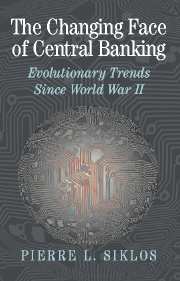Book contents
- Frontmatter
- Contents
- List of Figures
- List of Tables
- Preface
- 1 The Institutional Make-Up and Evolution of Central Bank–Government Relations: An Introduction
- 2 Legislation Alone Does Not a Central Bank Make: Political Structure, Governance, and Reputation in Monetary Policy
- 3 Central Bank Personalities and Monetary Policy Performance
- 4 Econometric Analysis of Central Bank Behavior: An Evolutionary Approach
- 5 Contrasting Quantitative and Qualitative Assessments of Central Bank Behavior and the Evolution of Monetary Policies
- 6 Accountability, Disclosure, and Conflict Resolution
- 7 Inflation Targets versus Other Inflation Control Measures: Two Sides of the Same Coin?
- 8 The Changing Face of Central Banking: Epilogue
- Bibliography
- Index
- Titles in the series
1 - The Institutional Make-Up and Evolution of Central Bank–Government Relations: An Introduction
Published online by Cambridge University Press: 27 October 2009
- Frontmatter
- Contents
- List of Figures
- List of Tables
- Preface
- 1 The Institutional Make-Up and Evolution of Central Bank–Government Relations: An Introduction
- 2 Legislation Alone Does Not a Central Bank Make: Political Structure, Governance, and Reputation in Monetary Policy
- 3 Central Bank Personalities and Monetary Policy Performance
- 4 Econometric Analysis of Central Bank Behavior: An Evolutionary Approach
- 5 Contrasting Quantitative and Qualitative Assessments of Central Bank Behavior and the Evolution of Monetary Policies
- 6 Accountability, Disclosure, and Conflict Resolution
- 7 Inflation Targets versus Other Inflation Control Measures: Two Sides of the Same Coin?
- 8 The Changing Face of Central Banking: Epilogue
- Bibliography
- Index
- Titles in the series
Summary
INTRODUCTION
As the twenty-first century begins, central banking would appear to be at a crossroads. From lender of last resort, to active participant in stabilizing economic fluctuations, and now as the guardian of price stability, much is expected from the monetary authority. Indeed, where once fiscal policy was considered the main instrument of economic policy, the ascendancy of monetary policy became especially noticeable by the late 1980s in much of the industrialized world with profound implications for the role of the central bank. Yet, as this is written, financial innovations seemingly threaten once again the position of central banks as the dominant force responsible for ensuring financial stability and in influencing economic outcomes.
There is an important sense in which, over the past several decades, central banking has been at the mercy of whim or fashion. “At a time when the price level is rising and employment is relatively full, price stability takes precedence over full employment as a policy objective. At a time when prices are stable and unemployment is rising, on the other hand, employment becomes the prime objective. A better measure of central bank conservatism might be the length of time it takes for him to accept a change in conditions and adjust his thinking accordingly” (Whittlesey 1970: p. 225).
The above quote highlights the fact that the practice of central banking involves a considerable amount of learning and adaptation to a changing environment, a theme now gaining wider acceptance, both in terms of formal models (as in Sargent 1999) as well as in historical descriptions of central bank policies throughout this century (see Howitt 2000; Siklos 1999a).
- Type
- Chapter
- Information
- The Changing Face of Central BankingEvolutionary Trends since World War II, pp. 1 - 25Publisher: Cambridge University PressPrint publication year: 2002



